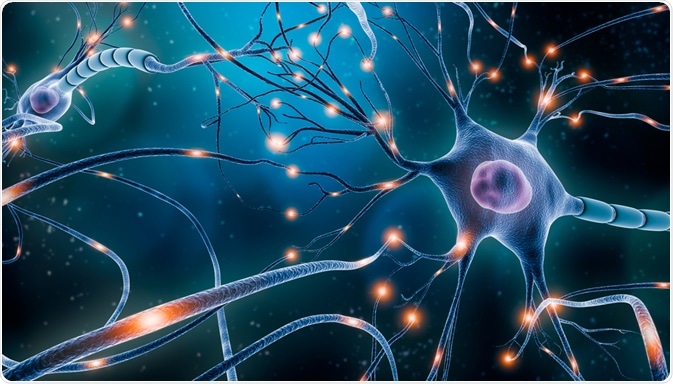Balo's disease, a rare variant of multiple sclerosis (MS), is a demyelinating disorder of the CNS in which the myelin (the fatty substance that covers nerve fibers) is destroyed. Balo’s disease is also known as concentric sclerosis or Balo concentric sclerosis because it is marked by bands of intact myelin (the sheath of fatty substances covering nerve fibers) alternating with rings of myelin loss (demyelination) in various sections of the brain and brain stem.

Image Credit: MattLphotography/Shutterstock.com
Causes and symptoms
The cause of multiple sclerosis and its variants remains unidentified to date. However, recent research suggests that autoimmune variables may play a role in the progression of Balo Disease. When the body's natural defenses against "foreign" or invading organisms (e.g., antibodies) start attacking healthy tissue for unknown reasons, autoimmune diseases develop.
Balo's disease can happen suddenly, over weeks or months, with no remission; a relapsing course (periods of symptoms followed by improvement or elimination of symptoms) can also occur, or a person can have a single attack (monophasic course).
The majority of cases are marked by the progressive onset of symptoms (muscle spasms and paralysis) similar to those seen in the prevalent form of MS. Other neurological symptoms (intellectual impairment and physiological problems) may occur depending on the parts of the brain that are affected.
The symptoms of Balo’s disease also include seizures, aphasia (difficulty speaking or understanding speech), cognitive loss (difficulty processing information), high fever, and headache. Although some cases have a subacute onset, the disease most usually has an acute onset. Initial symptoms typically include mental and behavioral problems, which progress to serious deficiencies within a few months, including paralysis and seizures.
Epidemiology
Balo's disease appears to be most common among east Asians, with the highest prevalence among southern Han Chinese, Taiwanese, and Filipinos. It rarely affects the white population. It appears to afflict females more frequently than males, and it usually manifests in adults, however, there have been reports of occurrences in children. Balo's disease occurs at an average age of 34 years (range 3–62 years).
Association with multiple sclerosis
The link between Balo lesions and multiple sclerosis is not completely understood. Balo's concentric sclerosis could be a different but related disease or a real variety of multiple sclerosis. Balo's disease and conventional multiple sclerosis share more than merely pathology similarities.
Balo lesions can develop within the course of generally standard relapsing-remitting multiple sclerosis. At least 55% of individuals with a Balo or Balo-like lesion on their MRI scan also have typical multiple sclerosis lesions elsewhere.
Prognosis
Patients who acquire signs of a Baló lesion have a mixed prognosis. There have been reports of complete clinical and radiological recovery; however, patients with aggressive Balo's concentric sclerosis may die or suffer significant morbidity.
Intermediate results between these two extremes appear to be more prevalent. Data on the outcomes of individuals who develop a Balo lesion as part of their relapse remitting multiple sclerosis compared to those who develop a Baló lesion as part of their relapsing-remitting multiple sclerosis is rare.
Diagnosis and treatment
The diagnosis begins with an examination of the medical history. Further diagnosis involves neurologic examination, MRI scan (brain, optic nerves, and spinal cord), lumbar puncture (to examine cerebrospinal fluid), blood tests (to detect possible infections), and evoked potential testing (to find lesions or damaged areas).
Clinical studies are scarce because Balo's is a rare disease, and no drugs have been specifically approved to treat it. However, corticosteroids may be used to treat the disease and reduce inflammation in the afflicted parts of the brain and spinal cord. Intravenous immunoglobulin (IVIG), plasma exchange, and chemotherapy (such as cyclophosphamide) are some of the other treatments available.
Certain drugs and referrals to rehabilitation professionals are used to treat symptoms like spasticity, weakness, discomfort, or ataxia. While Balo's disease frequently causes severe impairment or death within months, an increasing number of people are surviving or experiencing spontaneous remission with no further symptoms. Balo's disease might also exist without causing any symptoms. Symptomatic and supportive treatment is used.
Looking forward
Balo's disease is a rare demyelinating disease subtype with distinct radiological and pathological characteristics. The natural history of the disease varies, according to MRI, however, symptomatic lesions can be recovered with aggressive treatment. Disease-modifying therapy for multiple sclerosis may be a viable treatment option in certain patients who meet diagnostic criteria for the disease, although research is limited.
Despite advances in MRI-based understanding of Balo's disease, there are still significant areas of doubt. Because of the disease's rarity, major research on the disease has not been conducted. To reach sufficient numbers of patients and to draw conclusions about various features of the condition, a worldwide collaborative research or disease registry is required.
Such retrospective or prospective case series could provide helpful information on geographical variations in incidence, the frequency of association with multiple sclerosis (and other neurological disorders), prognostic features, and the effects of acute and long-term disease-modifying treatments. All of this could aid in the development of evidence-based treatment guidelines.
These findings will be advantageous in determining how a rising number of disease-modifying multiple sclerosis medications influence Balo's concentric sclerosis when it is assumed to be a manifestation of multiple sclerosis, as well as guiding treatment options.
References:
- Sotircho, E. (2019). Balo’s Disease. [online]. National Multiple Sclerosis Society. Available at: https://www.nationalmssociety.org/What-is-MS/Related-Conditions/Balo%E2%80%99s-Disease
- Hardy, T. A., & Miller, D. H. (2014). Baló's concentric sclerosis. The Lancet. Neurology, 13(7), 740–746. https://doi.org/10.1016/S1474-4422(14)70052-3
- Kira J. (2011). Astrocytopathy in Balo's disease. Multiple sclerosis (Houndmills, Basingstoke, England), 17(7), 771–779. https://doi.org/10.1177/1352458511400475
- Balo Disease. [online] National Organization for Rare Diseases. Available at: https://rarediseases.org/rare-diseases/balo-disease/
Further Reading
- All Rare Disease Content
- Teaching old drugs new tricks – drug repurposing for rare diseases
- What is Agnosia?
- What is Ameloblastoma?
- What is Apert Syndrome?
Last Updated: Dec 1, 2021
Source: Read Full Article
